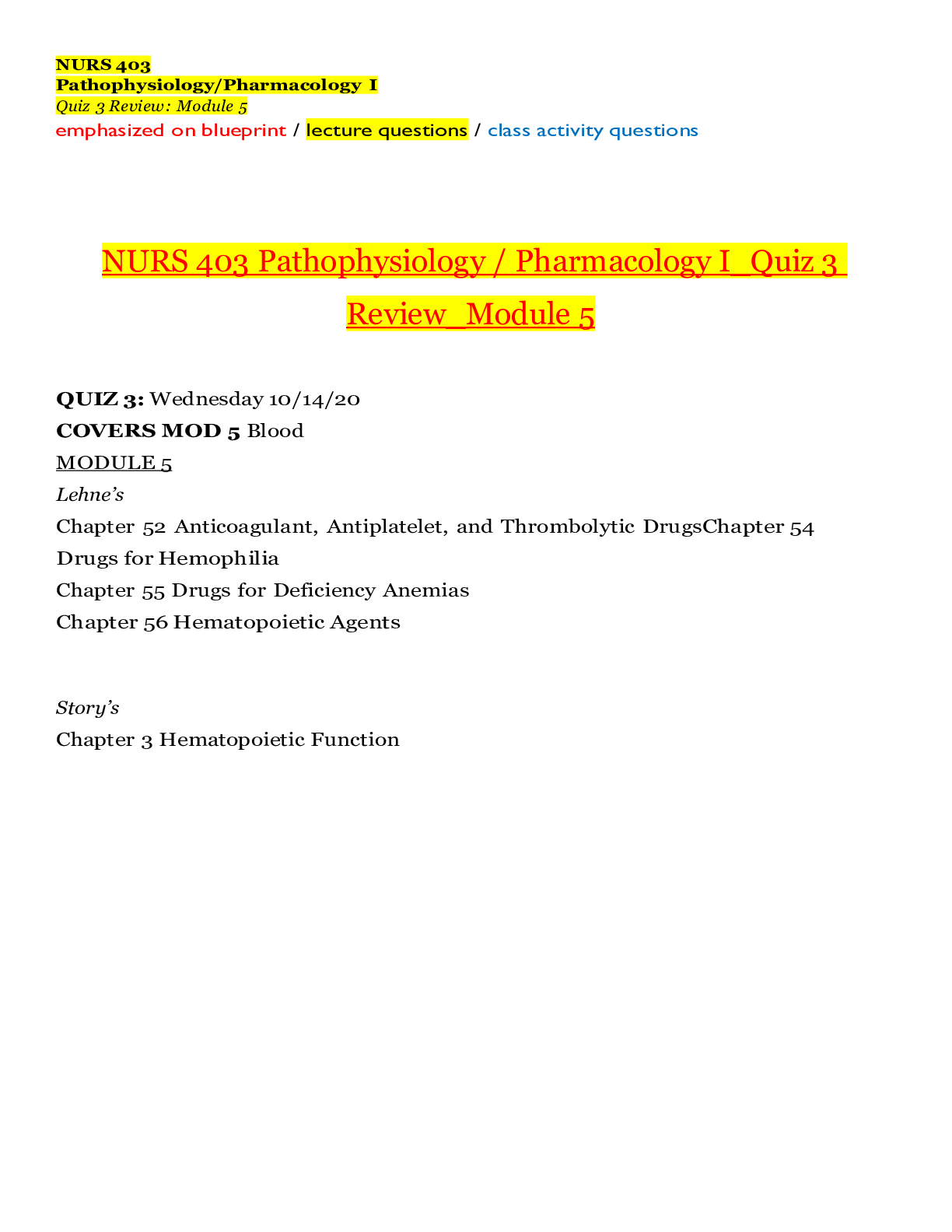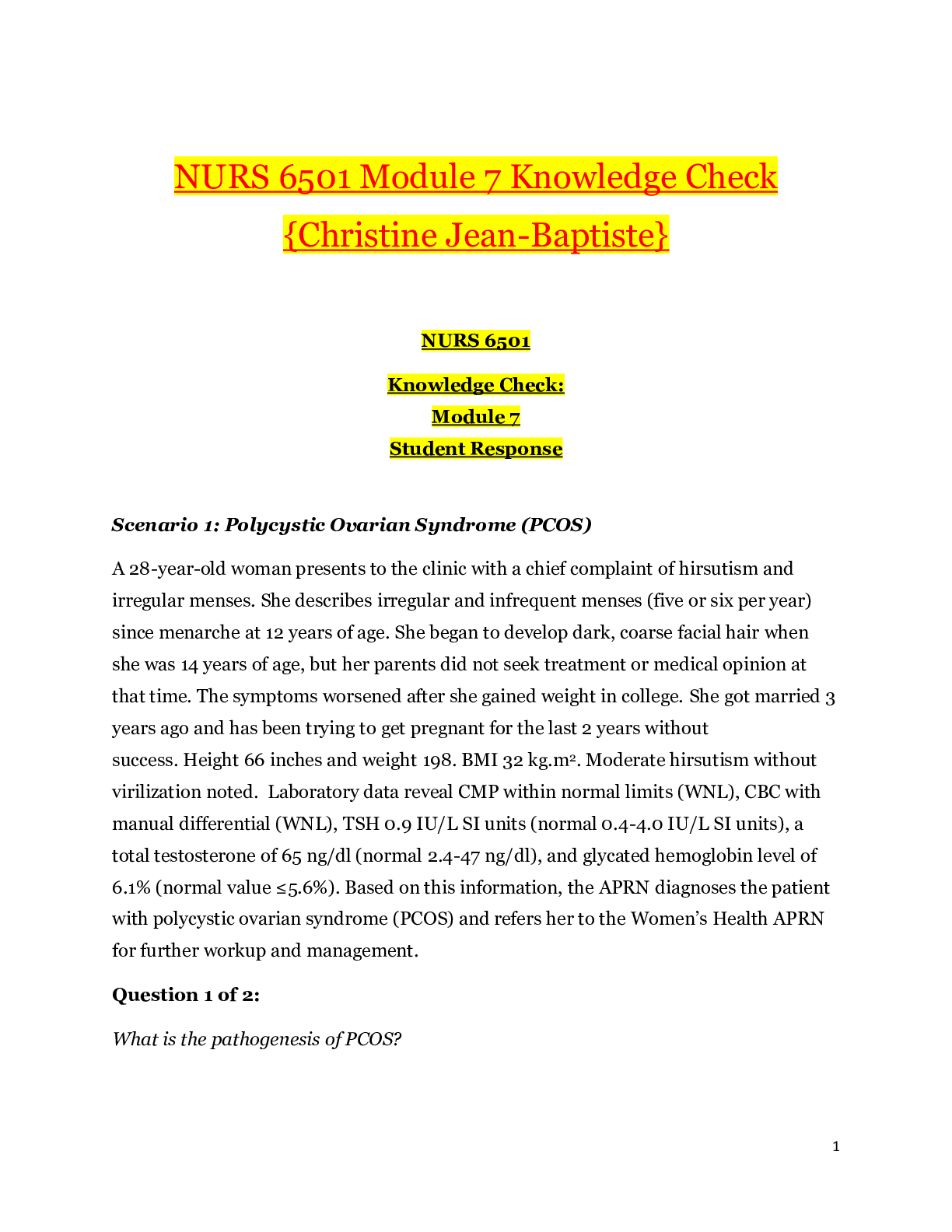Physiology > EXAM > NURS 403 Pathophysiology / Pharmacology I_Quiz 3 Review_Module 5_2020 | NURS403 Pathophysiology / Ph (All)
NURS 403 Pathophysiology / Pharmacology I_Quiz 3 Review_Module 5_2020 | NURS403 Pathophysiology / Pharmacology I_Quiz
Document Content and Description Below
NURS 403 Pathophysiology / Pharmacology I_Quiz 3 Review_Module 5 QUIZ 3: Wednesday 10/14/20 COVERS MOD 5 Blood MODULE 5 Lehne’s Chapter 52 Anticoagulant, Antiplatelet, and Thrombolytic Drugs Ch... apter 54 Drugs for Hemophilia Chapter 55 Drugs for Deficiency Anemias Chapter 56 Hematopoietic Agents Story’s Chapter 3 Hematopoietic Function What is the term for the process of blood formation? Hematopoiesis What is produced by bone marrow? Stem cell precursors What is the term for liquid protein and what is it responsible for? Plasma -transport of blood cells, antibodies, nutrients, electrolytes, hormones, lipids, and waste What type of blood cells are erythrocytes and what are they responsible for? Red blood cells -O2 and CO2 transport What component of red blood cells/erythrocytes gives it red color? Hemoglobin (Hgb) Define hematocrit The percentage of blood volume that contains RBCs What are leukocytes and what are they responsible for? White blood cells -inflammatory response What are thrombocytes and what are they responsible for? What are the steps by which thrombocytes carry out their function? What substance dissolves blood clots? -Coagulation through clotting factors Once there is damage to tissue cells production of thromboplastin carry out clotting Plasmin recap- RBCs contain hemoglobin; define globin How much hemoglobin is globin: the polypeptide chain/the structure 250 million Hgbs/RBC found in every red blood cell? Globin contains heme; what is heme responsible for? heme contains iron which binds to oxygen How many hemes are found in each globin structure? 4 hemes; which each bind to an oxygen, thus 4 oxygens recap- hematocrit is the % of RBCs per total blood volume what is hematocrit an indicator of? -red blood cell size -red blood cell number How many RBCs are there for every micro-centiliter? 5 million RBCs/1µcL What is the term for a condition in which there is a reduction of red blood cell count? Anemia -low red blood cell count -low hemoglobin (Hgb) -low hematocrit (Hct) What is considered a low Hgb count for males and females respectively? Males: < 13.5 g/dL (normal 13.5-18.0 g/dL, or 8.6 to 11.2 mmol/L) Females: < 12 g/dL (normal 12.0 to 15.1 g/dL, or 7.5 to 9.4 mmol/L) What is considered a low hematocrit count for males and females respectively? Males: < 41% (normal 41-52%) Females: < 37% (normal 37-46%) What is the normal RBC count for males and females respectively? When patients have a loss of RBCs, their oxygen will Males: 4.7 to 6.1 million cells/mcL Females: 4.2 to 5.4 million cells/mcL Respiratory rate will increase [tachypnea (or dyspnea, which is more defined as difficult/labored breathing)] decrease; how does the body compensate for this? Pulse/Heart rate will increase (tachycardia and angina) What CNS effects does anemia have on a patient? anemia decreased O2 delivery fatigue, HA (headaches), irritability, syncope, reduced concentration, RLS (restless leg syndrome) What organ will be targeting upon anemia? Ch. 56 1. A nursing student asks a nurse why patients with chronic renal failure (CRF) have low erythrocyte counts. Which response by the nurse is correct? anemia decreased O2 delivery targets kidneys kidneys will produce erythropoietin stimulation of bone marrow to increase production of RBCs What are signs of decreased oxygen to tissues? -pallor -koilonychia (spoon nails; abnormally thin nails which have become flat or even concave in shape) -cyanosis -decreased healing Normally, how are red blood cells produced? kidney produces erythropoietin erythropoiesis is carried out bone marrow will be stimulated hemopoietic stem cell is produced matures into an erythroblast matures into reticulocytes erythrocytes What is the life span of an RBC? 120 days What can lead to a reduction in the DNA precursors for erythropoiesis? -tumors -fibrosis -viral dx -CKD, RF (chronic kidney disease and renal failure) What type of anemia(s) are a result of a reduction in the DNA precursors for erythropoiesis? -pernicious anemia (megaloblastic or B12-deficiency) -folate deficiency type anemia Abnormal Hgb production will result in what types of -Fe deficiency anemia, anemia of chronic dx, sideroblastic anemia, thalassemia, sickle-cell anemia anemia? What can lead to either aplastic anemia or hemolytic anemia? -autoimmune disorders, bacterial infections, viral infections, deficiency of 6GPD, or blood loss due to menstruation, surgery, ulcers Reticulocytes in patients with an increase in bone- marrow activity Reticulocytes in patients with a decrease in bone- marrow activity > 3% < 3% Genetics plays a role in what type(s) of anemia? -aplastic anemia -hemolytic anemia What helps to classify the type of anemia? MCV (mean corpuscular volume) What does it mean when the MCV is between 80- 100, < 80, and >100? MCV 80-100 = normocytic anemia MCV < 80 = microcytic anemia MCV > 100 = macrocytic anemia List examples of microcytic anemia List examples of normocytic anemia List examples of macrocytic anemia iron deficiency, thalassemia, chronic disease, lead poisoning acute bleeding, aplastic anemia, hemolytic anemia, low erythropoietin, malignancy pernicious anemia, low folate What problem causes microcytic anemia (e.g. thalassemia)? What problem causes Fe deficiency anemia or anemia associated with chronic disease? -Problem with globin; abnormal alpha and beta chains of the globin structure -Problem with heme part of Hgb When taken in from the diet and absorbed through our GI, how does iron then move to our blood? How is our iron then stored in our liver? Transferrin carries iron out of our GI and into our blood Ferritin, another protein, stores iron in our liver To diagnose anemia, what lab levels do we measure, and what would we expect to see? CBC & Iron Studies -Serum Fe: decreased -% of iron saturation (% of Fe bound to transferrin): decreased (normal = ~33%) -Total Fe-binding capacity (transferrin): increased (for compensation) -Ferritin (stored Fe): decreased (w/ prolonged anemia) Ch. 55 1. A nurse is reviewing a patient's most recent blood count and notes that the patient has a hemoglobin of 9.6 gm/dL and a hematocrit of 33%. The nurse will notify the provider and will expect initial treatment to include: [Show More]
Last updated: 2 years ago
Preview 1 out of 58 pages

Buy this document to get the full access instantly
Instant Download Access after purchase
Buy NowInstant download
We Accept:

Reviews( 0 )
$14.00
Can't find what you want? Try our AI powered Search
Document information
Connected school, study & course
About the document
Uploaded On
Apr 23, 2021
Number of pages
58
Written in
Additional information
This document has been written for:
Uploaded
Apr 23, 2021
Downloads
0
Views
63

.png)













